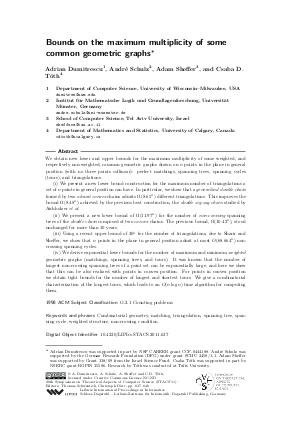Bounds on the maximum multiplicity of some common geometric graphs
Authors Adrian Dumitrescu, Andre Schulz, Adam Sheffer, Csaba D. Toth
-
Part of:
Volume:
28th International Symposium on Theoretical Aspects of Computer Science (STACS 2011)
Part of: Series: Leibniz International Proceedings in Informatics (LIPIcs)
Part of: Conference: Symposium on Theoretical Aspects of Computer Science (STACS) - License:
 Creative Commons Attribution-NonCommercial-NoDerivs 3.0 Unported license
Creative Commons Attribution-NonCommercial-NoDerivs 3.0 Unported license
- Publication Date: 2011-03-11
File

PDF
LIPIcs.STACS.2011.637.pdf
- Filesize: 0.79 MB
- 12 pages
Document Identifiers
Subject Classification
Keywords
- combinatorial geometry
- matching
- triangulation
- spanning tree
- spanning cycle
- weighted structure
- non-crossing condition
Metrics
- Access Statistics
-
Total Accesses (updated on a weekly basis)
0Document
0Metadata
Abstract
We obtain new lower and upper bounds for the maximum multiplicity of some weighted, and respectively non-weighted, common geometric graphs drawn on $n$ points in the plane in general position (with no three points collinear): perfect matchings, spanning trees, spanning cycles (tours), and triangulations. (i) We present a new lower bound construction for the maximum number of triangulations a set of $n$ points in general position can have. In particular, we show that a generalized double chain formed by two almost convex chains admits Omega (8.65^n) different triangulations. This improves the bound Omega (8.48^n) achieved by the previous best construction, the double zig-zag chain studied by Aichholzer et al. (ii) We present a new lower bound of Omega(11.97^n) for the number of non-crossing spanning trees of the double chain composed of two convex chains. The previous bound, Omega(10.42^n), stood unchanged for more than 10 years. (iii) Using a recent upper bound of 30^n for the number of triangulations, due to Sharir and Sheffer, we show that n points in the plane in general position admit at most O(68.664^n) non-crossing spanning cycles. (iv) We derive exponential lower bounds for the number of maximum and minimum weighted geometric graphs (matchings, spanning trees, and tours). It was known that the number of longest non-crossing spanning trees of a point set can be exponentially large, and here we show that this can be also realized with points in convex position. For points in convex position we obtain tight bounds for the number of longest and shortest tours. We give a combinatorial characterization of the longest tours, which leads to an O(n log n) time algorithm for computing them.
Cite As Get BibTex
Adrian Dumitrescu, Andre Schulz, Adam Sheffer, and Csaba D. Toth. Bounds on the maximum multiplicity of some common geometric graphs. In 28th International Symposium on Theoretical Aspects of Computer Science (STACS 2011). Leibniz International Proceedings in Informatics (LIPIcs), Volume 9, pp. 637-648, Schloss Dagstuhl – Leibniz-Zentrum für Informatik (2011)
https://doi.org/10.4230/LIPIcs.STACS.2011.637
BibTex
@InProceedings{dumitrescu_et_al:LIPIcs.STACS.2011.637,
author = {Dumitrescu, Adrian and Schulz, Andre and Sheffer, Adam and Toth, Csaba D.},
title = {{Bounds on the maximum multiplicity of some common geometric graphs}},
booktitle = {28th International Symposium on Theoretical Aspects of Computer Science (STACS 2011)},
pages = {637--648},
series = {Leibniz International Proceedings in Informatics (LIPIcs)},
ISBN = {978-3-939897-25-5},
ISSN = {1868-8969},
year = {2011},
volume = {9},
editor = {Schwentick, Thomas and D\"{u}rr, Christoph},
publisher = {Schloss Dagstuhl -- Leibniz-Zentrum f{\"u}r Informatik},
address = {Dagstuhl, Germany},
URL = {https://drops.dagstuhl.de/entities/document/10.4230/LIPIcs.STACS.2011.637},
URN = {urn:nbn:de:0030-drops-30505},
doi = {10.4230/LIPIcs.STACS.2011.637},
annote = {Keywords: combinatorial geometry, matching, triangulation, spanning tree, spanning cycle, weighted structure, non-crossing condition}
}
